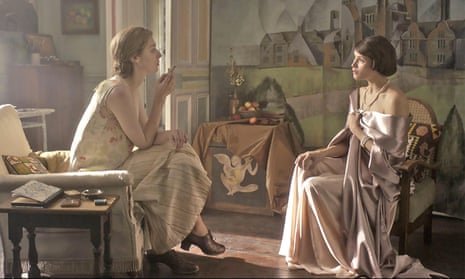A familiar set of headlines last week: Brits are growing more prudish. The James Bond film From Russia With Love would today be slapped with a higher age rating: modern audiences fret about the violence. A long sex scene in the 2018 film Vita & Virginia would now move it from a 12A to a 15. We are, meanwhile, growing more worried about references to suicide and misogynistic language. You can’t say anything these days.
But within the findings of the vast research project conducted by the British Board of Film Classification (BBFC) was a little noticed second story: Brits are growing less prudish. We are getting more relaxed about cannabis on screen: a new biopic of Bob Marley would previously have been a slam dunk for a 15 rating, according to Natasha Kaplinsky, the board’s president. It will now be a 12A. We are also less bothered about older teens seeing references to sex, especially in a comic context: risqué jokes that used to merit an 18 rating might now get a 15. You can say everything these days.
These findings are a small but sturdy challenge to a tale we have been telling for a decade: that we live in ever more censorious times. Young people, and parents, a well-established narrative runs, are growing increasingly fearful of corrupting influences and views with which they disagree. But we forget that the opposite is also true. Society is simultaneously becoming more tolerant of other types of speech: swearing, for example, and non-violent references to sex. The monarchy, Christianity, the British empire – these were once untouchable subjects. Now they aren’t. Even as we tut-tut over new taboos, we are also quietly shedding old ones. An obvious point has been missed by those who like to complain that free speech is dead and political correctness has gone mad. There was no point in history where absolutely nothing was censored: as time passes, the unsayable simply shifts from one topic to another.
There is perhaps no better illustration of how norms change than the BBFC’s five-yearly audience survey, in which it consults some 10,000 people. This is the organisation responsible for the age ratings you see in little circles or triangles before the start of films, but for more than a century it has also been doing something else: asking a wide range of people what they find offensive, and drawing up guidelines that reflect the mood of the times.
Between 1913 and 1915, for example, informed by public expectations, the BBFC listed 43 grounds for deleting scenes from films. Scenes “holding up the King’s uniform to contempt or ridicule” were considered particularly troubling, as were “subjects dealing with India, in which British officers are seen in an odious light”, the “relations of capital and labour”, scenes “tending to disparage public characters and institutions” and the “unnecessary exhibition of under-clothing”. Yes, in the first part of the last century, Britain was absolutely full of snowflakes.
In the 1950s, new moral quandaries arose as panic over a group then known as “juvenile delinquents” delayed films about biker gangs, and a picture about a mother and daughter who become nudists was deemed unacceptable: it showed bare buttocks.
In the 1960s, amid a new spirit of liberalism, the BBFC declared it would no longer “refuse to pass films which criticise ‘the Establishment’”, but drew the line at themes of abortion. Then, in the 1970s, came a shift in two directions. The BBFC grew more permissive where it came to sex but simultaneously clamped down on sadistic and sexual violence. A 1973 cut for sexual explicitness made to Last Tango in Paris was put back in 1978. But that same year a new cut was made to Emmanuelle, originally rated in 1974, removing a rape scene that, although not explicit, suggested rape could teach the victim a valuable lesson.
In the 1990s, audiences grew worried about violent content; in the wake of the murder of the toddler James Bulger by two 10-year-old boys, they became keen for stricter age ratings. The 00s was fraught with concerns about the depiction of drugs, but more easygoing about sex: films such as The Piano Teacher and Intimacy were the result.
What we allow ourselves to watch in the cinema is revealing of the times. Tracing these changing mores can give us a wider perspective on our own era. It shows us that we are not uniquely uptight, nor uniquely permissive. The range of acceptable ideas has merely shifted.
There is a trend, of course, to the shift. Britain, like much of the western world, has over the past century moved in a progressive direction. This means taboos have tended to accumulate at one end of the social spectrum: racism, sexism and derogatory language towards disadvantaged groups are growing less acceptable (colloquially, we might call this “punching down”). But taboos have also melted away at the other end. Ruling institutions, dignified public figures, majority religions and the reputation of our country at large can now be more easily criticised and made fun of (we might call this punching up).
This is a subtlety that tends to escape today’s so-called free speech warriors, a group that reaches into government, which focuses on new restrictions to punching down, and tends to see fewer problems with rules that might prevent people punching up.
This is why, in recent years, Brits have suffered the strange spectacle of a government that laments “cancel culture” and appoints a “free speech tsar” to deal with censorious students, but cracks down on the right to protest. In 2022, new laws permitted noisy demonstrations to be shut down, increased the length of prison sentences for damaging statues and broadened the definition of “intentionally or recklessly causing public nuisance”, a criminal offence. Police will soon be able to arrest protesters for wearing face coverings to hide their identity.
Our leaders do not recognise that free speech runs both ways. If those at the top of social hierarchies want to say what they like about those at the bottom, they should consider returning the favour. If they’re looking for a simple introduction to the concept of free speech, they could do worse than flicking through our history of film censorship – it’s an enjoyable read.
Martha Gill is an Observer columnist
Do you have an opinion on the issues raised in this article? If you would like to submit a letter of up to 250 words to be considered for publication, email it to us at observer.letters@observer.co.uk

